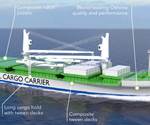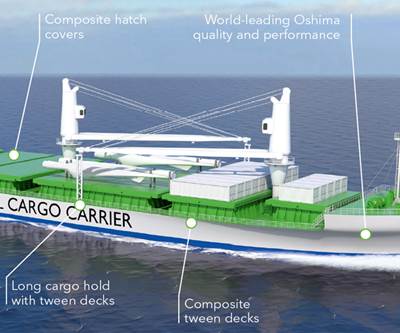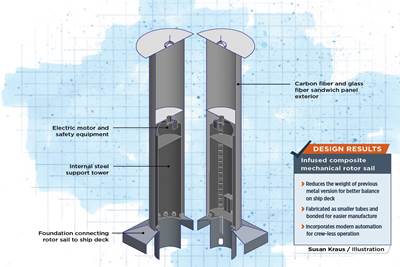The 20-meter AirWing installation aboard the Carisbrooke Shipping vessel maintains compatibility with cargo operations while delivering 8.3% fuel savings during the vessel's U.K.-Canada-U.K. route. Source (All Images) | GT Wings
The global maritime industry is navigating a transformative period as regulatory pressure intensifies to reduce greenhouse gas emissions. With fuel consumption reaching approximately 300 million tonnes annually and accounting for 2.5% of global carbon emissions, shipping operators face difficult compliance challenges. The International Maritime Organization (IMO) has established increasingly stringent Energy Efficiency Design Index (EEDI) and Energy Efficiency Existing Ship Index (EEXI) requirements, while the European Union prepares to incorporate shipping into its Emissions Trading System (EU ETS) and implement FuelEU Maritime regulations. These developments are forcing vessel operators to adopt decarbonization strategies that balance environmental compliance with operational viability.
Wind-assisted propulsion systems have emerged as a particularly promising technology, using a free and unlimited energy source to reduce fuel consumption. However, traditional systems often present significant operational challenges, notably excessive deck space requirements that interfere with cargo operations and insufficient thrust-to-size ratios that limit fuel-saving potential.
GT Wings (Liverpool, U.K.) has developed a new approach to maritime wind propulsion that addresses these limitations. The AirWing system is a commercially available wingsail that combines aerodynamic principles borrowed from America’s Cup and Formula 1 racing with a specialized composite construction optimized for large-scale manufacturing techniques. Together, these features deliver exceptional thrust from a compact footprint, making wind propulsion viable even for vessels with limited deck space.
Wingsail design

A rendered visualization of the AirWing in its deployed configuration. GT Wings has developed multiple size variants including the AirWing20, AirWing28 and AirWing40, each tailored for different vessel sizes.
The fundamental challenge in maritime wind propulsion has been developing a system that delivers significant thrust from a compact unit while maintaining compatibility with vessel operations.
“Traditional thinking equates more sail area with more thrust,” explains Martin Harrop, manufacturing expert at GT Wings. “Our approach inverts this paradigm by maximizing thrust efficiency through advanced airflow manipulation.”
The foundation of AirWing technology lies in the specialized aerodynamic intelligence developed by company founder George Thompson, whose background includes work with America’s Cup racing teams. Thompson identified an opportunity to apply boundary layer control techniques typically used in high-performance racing applications to commercial maritime propulsion.
“The AirWing manipulates airflow in a way that has never been implemented in the shipping industry before,” explains Thompson. “Rather than simply scaling up conventional wingsail designs, we’ve engineered a system that fundamentally rethinks how air interacts with the wing surface.”
The resulting design employs a multielement solid wing construction consisting of two aerodynamic surfaces — a main element and a flap — that work together to generate propulsive force. Unlike soft sails, this rigid vertical wing functions similarly to an aircraft wing, creating lift through pressure differentials as air flows over its curved surfaces. The main element provides the primary lifting surface, while the smaller flap element, positioned at the trailing edge, acts as a high-lift device that can be adjusted to optimize the overall aerodynamic performance of the system.
The key advantage of the multielement configuration lies in its ability to maintain attached airflow at higher angles of attack than single-element designs. When properly configured, the slot between the main element and flap accelerates airflow from the high-pressure (windward) side to the low-pressure (leeward) side, energizing the boundary layer and delaying flow separation. This slot effect allows the wingsail to generate significantly more drive force before stalling, particularly important when sailing upwind or in light air conditions. As the flap angle can be adjusted independently of the main element, it provides fine control over the camber and overall lift coefficient of the combined system.
An automated control system, which incorporates a series of sensors and actuators, continuously adjust both the angle of attack of the main wing assembly and the relative position of the flap element. The system automates trim optimization that responds to changing wind conditions, boat speed and heading.
Hybrid material architecture
Translating this aerodynamic intelligence into a practical maritime solution required sophisticated design engineering and material manufacturing expertise. The AirWing system underwent comprehensive design validation through a multistage finite element analysis testing protocol with appropriate safety factors verified in the structural design under various load cases, with particular attention paid to the dynamic forces experienced in maritime conditions.
GT Wings partnered with KS Composites (Melton Mowbray, U.K.) and A2O Manufacturing (Liverpool, U.K.) to develop a bespoke production system for the 20-meter AirWing prototype destined for installation on a Carisbrooke Shipping vessel in late 2024.
The engineering team made a strategic design decision to employ a hybrid material architecture that balances performance, manufacturability and certification requirements. A central steel spar provides the primary load-bearing structure, with composite aerodynamic surfaces attached creating the wing profile necessary for the system’s airflow manipulation technology.
“For the first demonstrator, we decided use a steel spar for the main structural element given the 12-month project timeline and certification requirements,” explains Harrop. “This simplified the certification process while enabling us to focus the composite development on the aerodynamic surfaces, which are critical to our airflow technology.”
The material selection process prioritized both performance and manufacturability. For the primary aerodynamic structures, KS Composites selected SHD Composites’ (Sleaford, U.K.) MTC510LV-EBX1200 glass fiber prepreg with a ±45° biaxial fabric configuration at 1,200 grams/square meter areal weight.
“We specifically chose this material for its thickness to reduce manual labor time while providing an optimal surface finish,” explains Dan Newham, KS Composites project manager. “The high grammage enabled us to achieve the necessary structural properties with fewer plies, improving manufacturing efficiency.”
Cross-sectional view of the AirWing's composite construction reveals the sandwich panel design using Baltek SB 50 balsa core with thicknesses ranging from 9.5 to 31.8 millimeters. The glass fiber prepreg outer skin provides structural integrity while white cabling visible in the void supports the system's automated control mechanisms.
For the highly stressed flap spar, which spans 20 meters, the team employed SHD Composites’ MTC510LV-CBX800-35%RW carbon fiber prepreg using PX35 50K carbon fiber (Zoltek, Bridgeton, Mo., U.S.) This material provides the strength-to-weight ratio required for this critical structural component while maintaining compatibility with the manufacturing process.
The construction employs a sandwich panel design using Baltek SB 50 balsa core from 3A Composites Core Materials (Colfax, N.C., U.S.), with thicknesses of 9.5 and 31.8 millimeters depending on local structural requirements. This balsa core, with a nominal density of 109 kilograms/cubic meter, was selected over synthetic foam alternatives for both performance and sustainability reasons.
“The balsa core provides the required mechanical properties while offering significant environmental benefits,” notes Newham. “It sequesters carbon during its growth phase, requires less energy during processing than synthetic alternatives, and offers improved end-of-life recyclability and biodegradability.”
Manufacturing intelligence
KS Composites developed a sophisticated manufacturing process to produce the large-scale composite components required for the AirWing system. The production workflow begins with precision kit cutting using an Assyst Bullmer (Wakefield, U.K.) rolling bed cutter to create optimized material layouts, ensuring consistent ply geometry and maximizing material yield.
The laminating process is performed manually, with the kit-cut prepreg plies laid up in specialized molds. “During the design for manufacture phase, we engineered the molds with built-in forklift truck channels for easy loading into the autoclave,” explains Newham. “The mold tooling incorporates multiple cross-structures on the rear to ensure dimensional stability during processing.”
The curing process uses programmable autoclaves following precise cure cycles aligned with the material manufacturer’s specifications, eliminating potential process variations. The system is designed to cure at temperatures ranging from 80°C to 120°C, providing manufacturing flexibility while achieving glass transition temperatures of up to 125°C after post-cure.
The AirWing unit is testing its automatic adjustment system to achieve optimum performance in varying wind conditions. It enters “safe mode” at wind speeds above 45 knots to minimize drag when thrust generation becomes impractical.
A key manufacturing challenge was managing component size constraints while ensuring structural integrity across the full 20-meter span. The team determined that 4-meter sections represented the optimal balance between manufacturing capability and structural performance.
“The 4-meter section size was driven primarily by our autoclave capacity,” notes Newham. “This modular approach also improved handling logistics and simplified shipping to the installation site.”
The flap spar required particular attention to maintain structural continuity across its 20-meter-long assembled span. The team developed a specialized joining technique using 1.5-meter bonded “sleeves” that extend 750 millimeters into each adjoining 4-meter section, using 3M (Saint Paul, Minn., U.S.) DP490 adhesive to create a high-strength bond required for the application.
GT Wings engineering team and manufacturing partners review 3D simulations and performance data at KS Composites' facility. The collaborative development process incorporated expertise from America's Cup racing technology and Formula 1 aerodynamics to create a maritime propulsion solution that maximizes thrust from a compact footprint.
The manufacturing process also addressed the interface between composite components and the steel structure through detailed design of attachment points and load transfer zones. Most composite sections are bolted directly to the steel structure in 2-meter segments, with additional plies overlapping the edges of the balsa core to prevent delamination at these critical junctions.
Environmental protection was provided through a specialized coating system, PPG’s (Pittsburgh, Pa., U.S.) Sigmacover 280 primer and Sigmadur 550 topcoat to protect the composite structures from UV degradation and saltwater exposure while mitigating potential galvanic corrosion at metal-composite interfaces.
Material testing included lap shear tests to validate bond joint strength and mechanical property characterization of the composite laminates. The completed components underwent dimensional verification and ultrasonic inspection to ensure manufacturing quality and structural integrity.
“Through lap shear testing, we established minimum bond strength requirements to ensure structural integrity, with a 75% minimum bond ratio specified and an additional 5% safety factor implemented during production,” explains Newham. “Nondestructive testing using contact ultrasonic inspection verified that all bond joints met or exceeded these requirements.”
A precision-engineered bearing assembly that enables the AirWing’s rotational functionality undergoes inspection prior to installation. The steel components interface with composite structures through carefully designed attachment points and load transfer zones, with additional plies overlapping the edges of balsa cores to prevent delamination at these critical junctions.
Performance validation
The 20-meter AirWing unit installed on the Carisbrooke Shipping vessel delivers an expected 8.3% fuel and carbon emission savings on its U.K.-Canada-U.K. route, translating to annual cost savings exceeding £139,000. Over its 25-year lifespan, this single AirWing unit could reduce COâ‚‚ emissions by approximately 14,250 metric tonnes.
“We’ve simulated that the AirWing generates up to 30% fuel savings while maintaining compatibility with vessel operations,” notes Harrop. “It sits within the air-draft of the vessel and has minimal effect on cargo operations, addressing key adoption barriers for this type of wind propulsion technology.”
Aerial view of the AirWing installation process at port where the 20-meter unit is carefully positioned onto Carisbrooke’s Vectis Progress vessel ahead of its maiden voyage with the wingsail unit.
The system also implements sophisticated control automation, automatically adjusting to achieve optimum performance in varying wind conditions and moving to a “safe mode” at wind speeds above 45 knots to minimize drag when thrust generation becomes impractical.
GT Wings recently secured an additional £225,000 grant from the UK Department for Transport's Smart Shipping Acceleration Fund to further enhance the control system through AI and reinforcement learning, in collaboration with the University of Bath. This development will enable real-time optimization of the AirWing’s performance through self-learning algorithms.
Future development and industry impact
The successful implementation of the AirWing technology on its first commercial vessel represents a significant milestone in maritime decarbonization efforts. The technology's scalability is evident in GT Wings’ development of multiple size variants: AirWing20, AirWing28 and AirWing40, each tailored for different vessel sizes.
The manufacturing partners are already identifying process improvements for future production. KS Composites is working with SHD Composites to optimize materials by using larger rolls of 100-150 meters instead of the standard 25-50 meters, aiming to reduce production waste and improve manufacturing efficiency.
“Larger material rolls would eliminate significant backing paper waste and reduce setup time,” explains Newham. “We’re also investigating the performance implications of small resin content reductions to further optimize cost and sustainability.”
The team is also assessing opportunities to increase the proportion of composite materials in future iterations, potentially replacing the steel spar with advanced composite structures. This development would further reduce weight and improve system performance while maintaining structural integrity.
“The current hybrid approach balances performance with certification requirements and project constraints,” notes Harrop. “As the technology matures and regulatory familiarity increases, we anticipate opportunities to implement more advanced composite solutions.”
For the broader maritime industry, the AirWing technology represents a practical path to meaningful emissions reduction that can be implemented on existing vessels without compromising operations. With approximately 20,000 ships globally suitable for wind propulsion and only about 35 installations to date, the market potential is substantial.
Related Content
Smartbeam develops HMS-embedded composite profiles for space
Project goals adapted filament winding to properly integrate optical and carbon fiber sensors and meet technical requirements, resulting in a verified, simplified process for smart composite structures at reduced cost.
Read MoreExpanding high-temperature composites in India and the U.S.
Azista USA offers polymers and processes for carbon/carbon and other CMC, including novel hot-melt phenolic and phthalonitrile prepregs for faster cycle times, alternative solutions.
Read MoreTCR Composites introduces TR1116 snap-cure epoxy prepreg resin system
Designed for press-cure applications, the resin system is highlighted for its snap-cure capability and tailored properties.
Read MoreHexcel, Specialty Materials launch boron fiber-infused high modulus carbon fiber
High-compression, hybridized unidirectional prepreg targets advanced commercial and military application opportunities.
Read MoreRead Next
Lightweight at sea — get on board
Using composites to lightweight ships is gaining momentum. Several groups are available for materials and technology suppliers to join and help develop cost-effective solutions.
Read MoreModernizing the mechanical rotor sail
Composites are key for Norsepower’s award-winning redesign of a century-old rotor sail for reducing carbon emissions on passenger and cargo ships.
Read MoreUltrasonic welding for in-space manufacturing of CFRTP
Agile Ultrasonics and NASA trial robotic-compatible carbon fiber-reinforced thermoplastic ultrasonic welding technology for space structures.
Read More













